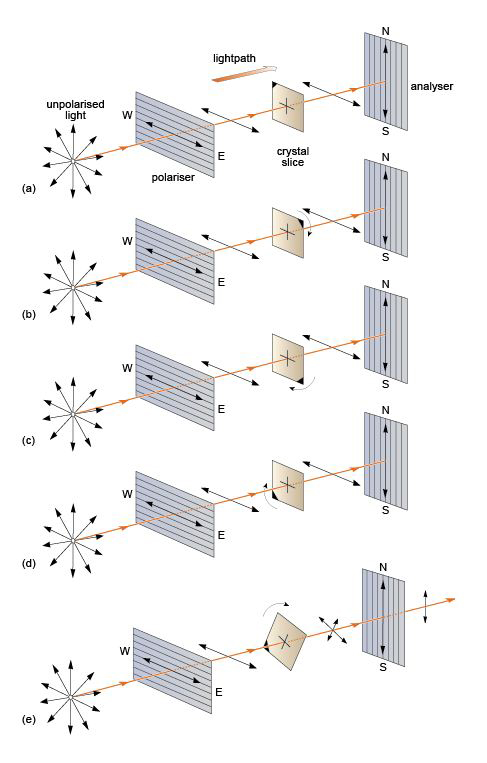2.2.4 Extinction positions
When two polarising filters are held up to the light and their permitted vibration directions are parallel, light is transmitted. If one of the filters is then rotated through 360º, there will be two positions (at 90º and 270°) when the vibration directions are at right angles to one another, and at which no light is transmitted. In these positions, the polarisers (often called polars) are thus said to be crossed.
-
How would the intensity of any transmitted light change if an isotropic crystal was rotated between two crossed polars?
-
No light would be transmitted, irrespective of the orientation of the crystal. Thus isotropic minerals always appear black when viewed between crossed polars.
If an anisotropic mineral is placed between the crossed polars, the result is quite different. On entering the crystal, the plane-polarised beam splits into two plane-polarised beams at right angles to each other, constrained to the permitted vibration directions of the crystal. When a permitted vibration direction is parallel to the plane of polarisation of the beam, however, the beam does not split and the polarised beam is transmitted in that same plane. On emerging, this beam is effectively blocked by the other (crossed) polariser. As this happens for both permitted directions of the crystal, and as each is parallel to the plane of polarisation twice in a full 360° revolution, four extinction positions at 90° to each other are observable when an anisotropic mineral is rotated between crossed polars.
These effects are summarised in Figure 31. In (a)-(d), white light enters the first polarising filter and is polarised in the east-west plane. In each case this plane coincides with one of the permitted vibration directions in the mineral (when in the east-west position). Light then passes through the mineral, still polarised in the east-west plane. However, it is polarised at right angles to the permitted vibration direction of the second polariser, which therefore prevents the light from passing. Darkness results and the mineral is in extinction.

Figure 31e illustrates what happens between extinction positions. Light that has passed through the first polarising filter is polarised in the east-west plane as before. On entering the mineral it splits into two rays, polarised at right angles by the anisotropic mineral. These two rays then enter the second polariser. Their planes of polarisation are at an angle to the permitted direction of the second polariser, which constrains the transmitted component of each ray to the north-south plane, and so light passes through. The intensity of the transmitted light varies gradually from zero at the positions of extinction to a maximum at each position halfway between the extinction positions.
